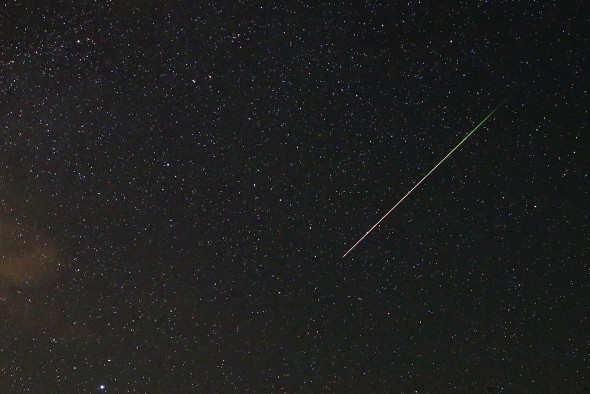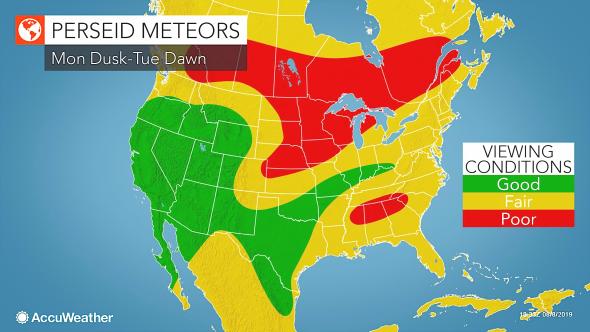Perseid meteor shower: How and when to see one of the best astronomical events of the year – AccuWeather.com
By Brian Lada, AccuWeather meteorologist and staff writer
August 08, 2019, 3:46:18 PM EDT
Shooting stars are about to rain down from the heavens and illuminate the night sky as the best meteor shower of the entire year, known as the Perseids, reaches its peak. However, clouds may interfere with some stargazers’ plans to watch the celestial light show.
“The Perseids are the most popular meteor shower as they peak on warm August nights as seen from the Northern Hemisphere,“ the American Meteor Society (AMS) explained on their website.
This year, the peak of the highly anticipated meteor shower falls on the night of Monday, Aug. 12, into the early morning hours of Tuesday, Aug. 13, according to the AMS.

A meteor streaks across the sky during the Perseid meteor shower near Kraljevine on mountain Smetovi in the early morning August 12, 2015. REUTERS/Dado Ruvic
Not only does the shower peak during the warm nights of mid-August, but it boasts an impressive number of meteors, second only to the Geminids in December.
“Up to 100 meteors per hour will occur during the peak night,” AccuWeather Astronomy Blogger Dave Samuhel said.
“Perseids are not only numerous, they are beautiful. Most of the meteors leave a glittering trail as they pass,” Samuhel said. “They are multi-colored and many are bright.”
However, this year the moon is likely to play a role in the number of shooting stars able to be seen on the peak night. The nearly-full moon will be shining bright nearly all night long, making it difficult to see many of the dimmer meteors. Cloudy conditions may also be an issue for some spectators.

Cloud-free conditions will lead to uninterrupted viewing conditions for some of the best stargazing locations across the country on Monday night as the Perseids peak. This includes most of the western United States, the southern Plains and a swath of the Ohio Valley.
Patchy clouds could interfere with viewing for many across the eastern U.S., but there should be enough breaks in the clouds to see some of the Perseids on Monday night.
Although onlookers in big cities, such as Chicago, Dallas, Los Angeles and Phoenix are forecast to have favorable weather, they may want to consider traveling to a darker area away from the light pollution in the city.
Unfortunately for those across the southeastern U.S., north-central U.S. and most of Canada, clouds are in the forecast that will obscure the sky most of the night.
When to see the Perseids
Shooting stars will be most numerous on Monday night into Tuesday morning, but this is not the only time when stargazers can see some of the shower.
“People should consider viewing meteors during the nights leading up to the peak,” Samuhel said. “There will still be plenty of meteors, and, you will not have to battle as much moonlight.”
As for when to head outside under the stars, folks may want to brew a cup of coffee if they hope to see the Perseids in all their glory.
“The Perseids are most active after midnight through daybreak. However, there are so many meteors during this shower, don’t hesitate to view during the evening,” Samuhel said.
Where to look during the meteor shower
As with every meteor shower, the Perseids are named after the part of the sky in which they originate, known as the radiant point. If you trace back all of the meteors during the upcoming shower, they will all originate from a part of the sky near the constellation Perseus.
The radiant point will be in the northeastern sky, but you do not need to focus on this area of the sky to see the meteor shower. In fact, meteors will be able to be seen in all areas of the sky.
Due to the moon, spectators this year should try to keep the moon out of their sight and look to the darkest part of the sky. This will help to increase the odds of seeing some meteors.
RELATED:
Follow AccuWeather Astronomy on Twitter
Why do meteors glow in vibrant colors?
5 dark sites perfect for stargazing in the United States
How light pollution dimmed the stars, Milky Way across the globe
After the Perseids, stargazers will need to wait until October for the next opportunity to watch a meteor shower.
The Draconid meteor shower is the next meteor shower to mark on your calendar, which falls on Oct. 8, followed by the Orionid meteor shower, which will take place on Oct. 21.





